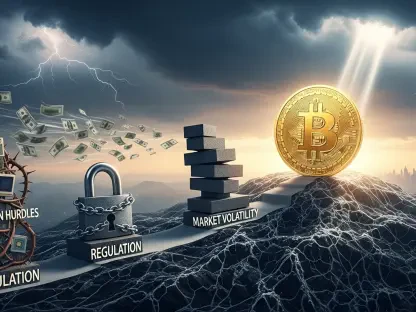Over recent years, the financial landscape has undergone a major transformation, particularly in the domain of cross-border payments. Cryptocurrencies have emerged as innovative solutions, redefining the way international transactions are conducted by addressing traditional inefficiencies associated with established systems like SWIFT. This evolution has reached a pivotal moment as SWIFT transitions to the ISO 20022 messaging standards, spotlighting cryptocurrencies like XRP, XLM, and others as potential game-changers in the sector. These digital assets promise faster transaction times, reduced costs, and enhanced transparency, all of which have significant implications for global financial systems.
Technological Compatibility and Improvement
Addressing Traditional Inefficiencies
The migration of SWIFT to ISO 20022 has marked a significant shift in financial messaging, characterized by enriched data structures and enhanced processing capabilities. Traditionally, SWIFT faced numerous challenges, including slow settlement times, high operational expenses, and limited transparency, which often frustrated stakeholders. Cryptocurrencies have emerged as viable solutions to these inefficiencies, particularly those such as XRP, XLM, XDC, and others, which are technologically compatible with the new standards. Ripple’s XRP, for example, plays a critical role as an ISO 20022 Standards Body member focused on Distributed Ledger Technology (DLT).
These digital assets utilize decentralized ledger technology to streamline transactions and provide near-instant settlement capabilities with minimal fees, contrasting sharply with conventional systems. Partnerships with leading financial institutions bolster XRP’s position, evidencing its capability to bridge existing gaps and revolutionize the sector. Consequently, cryptocurrencies have not only aligned with SWIFT’s evolution but have also introduced a more efficient framework that traditional systems struggled to achieve, suggesting a promising roadmap for the future of cross-border finances.
Integration into Modern Financial Infrastructure
Cryptocurrency platforms have increasingly been integrated into modern financial structures, reinforcing their potential to enhance existing frameworks rather than replace them entirely. Stellar’s XLM, in particular, has gained recognition for its remittance capabilities, aligning well with ISO 20022’s objectives to modernize and streamline financial messaging protocols. The strategic emphasis on blockchain technology is critical, allowing these cryptocurrencies to leverage API-based systems and smart contracts for real-time settlement and reconciliation—a fundamental aspect of next-generation financial systems.
This integration signifies a dynamic interplay between legacy systems and innovative blockchain technologies. Financial institutions are progressively adopting these digital solutions, embedding them into the fabric of conventional systems to facilitate smoother and more secure transactions. Through this synergy, a hybrid model emerges where advancements in decentralized technology coexist with longstanding protocols, ultimately enhancing the efficiency and security of global financial networks while making strides towards a future that transcends current limitations.
Regulatory and Market Dynamics
Navigating Macroeconomic and Regulatory Factors
The trajectory of cryptocurrencies in cross-border payments is not solely shaped by technological advances; macroeconomic and regulatory factors play a significant role. The market’s response has been influenced by legislative measures, such as the GENIUS Act, affecting the sentiment and performance of digital assets like XRP and XLM. Although projections suggest robust growth, risks persist, including potential regulatory hurdles and competition from stablecoins offering similar benefits. These factors compel institutions to carefully navigate the evolving landscape, balancing innovation with adherence to legal frameworks.
Regulatory scrutiny and compliance standards are paramount in defining the future of cryptocurrency adoption within financial systems. As legislative environments vary across regions, global harmonization remains a challenge. However, the persistent efforts to integrate these digital solutions into mainstream financial systems reflect a strategic endeavor to overcome such barriers. The regulatory landscape is expected to continue evolving, establishing a more cohesive approach that supports innovation while ensuring the integrity and stability of the financial ecosystem.
Strategic Shift Toward Blockchain Solutions
Financial institutions are strategically pivoting towards blockchain-based solutions, recognizing their potential to enhance efficiency and transparency. The ASOBANCA report underscores this shift as a documented strategy rather than mere speculation, pointing toward a comprehensive embrace of blockchain systems. Digital assets are increasingly viewed as pivotal components in rebalancing the global financial architecture, aiming to fill existing gaps in speed, cost, and transparency in cross-border transactions.
This paradigm shift marks a critical juncture where traditional financial mechanisms are being supplemented by cutting-edge digital solutions. By integrating blockchain infrastructure, institutions can harness the benefits of decentralized technology while maintaining the reliability of traditional networks. The ongoing transition suggests an encouraging trend toward a holistic financial ecosystem that capitalizes on the strengths of both conventional and modern technologies, paving the way for continued innovation and improved global financial connectivity.
Toward a New Financial Ecosystem
In recent years, the financial sector has seen a significant transformation, especially in the realm of cross-border payments. Cryptocurrencies have come to the forefront as disruptive forces, redefining how international transactions are executed by mitigating the inefficiencies often tied to traditional systems like SWIFT. Now, this evolution is at a crucial juncture with SWIFT’s shift to the ISO 20022 messaging standards, which highlight cryptocurrencies such as XRP and XLM as potential industry disruptors. These digital currencies hold the promise of faster transaction speeds, lower costs, and greater transparency, all of which have profound implications for the global financial infrastructure. As a result, the adoption of these innovative solutions could potentially reshape the way cross-border payments are handled, offering a glimpse into a more efficient and seamless future for international financial transactions. Overall, this shift marks a pivotal moment in the evolution of global finance, one that could redefine long-established processes.









